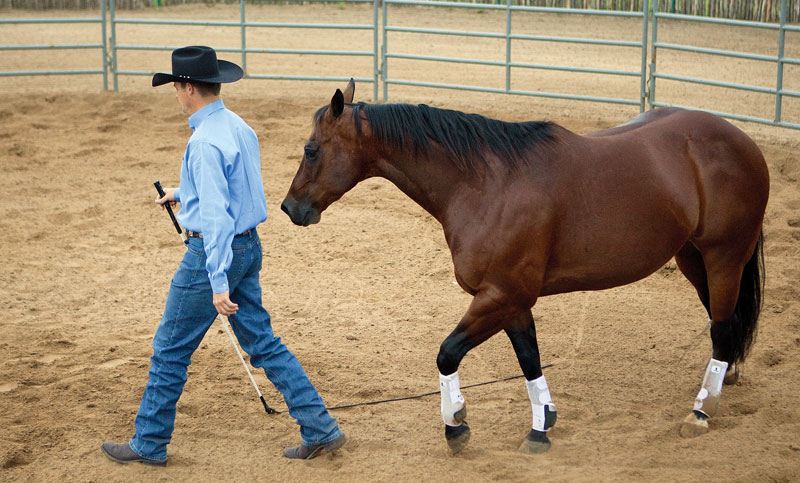Regardless of age or background, I begin all horses’ training in the round pen. As far as I’m concerned, the round pen is the safest area for you and your horse to initially build a relationship because you’re not connected to each other. Anytime you’re connected to a horse by a lead rope, you have to be relatively close to him. If he tried to do something disrespectful like kicking, biting or running over you, the chances of you getting hurt would be much higher. When you’re working with an unhandled older horse, this is an especially important safety factor to consider.

By working with your horse in the round pen, you’ll find out how athletic he is, how lazy or energetic he is, and how willing he is to move forward and follow your suggestions. These are all important factors to take into consideration as his training progresses.
Five Steps to Forming a Foundation
When round-penning a horse, your ultimate goal should be to teach him to move forward, backward, left and right in the direction you point. You also want him to “catch” you, rather than you having to catch him, by teaching him that the center of the round pen—being with you—is the most comfortable place to be. You’ll accomplish that goal by working on the five steps described here.
- Establish a Direction: The first step teaches your horse to be responsible for his feet. When you set him in a direction at a certain gait, he should continue that way until you tell him otherwise.
- Change of Direction to the Inside: Once your horse is going around the round pen without trying to stop and change direction on his own, ask him to do a change of direction to the inside. Always ask for the change to the inside so that he turns and faces you with both eyes before going the other way. Whenever your horse stops and turns toward the fence, he is trying to escape you instead of looking to you for security. You never want him to turn away from you.
- Consistent Change of Direction to the Inside: When your horse understands the basics of changing direction, you want to establish consistency every time you ask for it.
- Draw Your Horse in to You: You want your horse to realize that being with you is a safe place and that you’ll make him feel comfortable. He should acknowledge you, respect you and want to be with you. This is the step that will teach him how to “catch” you. A respectful horse will turn toward you, and even walk up to you, when you go out to catch him. A disrespectful horse will turn away from you and give you his heels.
- Teach Your Horse to Follow You: You want your horse to follow you around the round pen like your shadow—walking when you walk, turning when you turn, and stopping when you stop. When he follows you, he is making a conscious choice to be with you. He is paying attention to your every move and isn’t afraid to be with you. The more draw you can create in your horse, the easier it will be to progress his training.
Rescues in the Round Pen
Don’t treat a rescued horse differently in the round pen. Making excuses and special allowances for an abused horse’s bad behavior will only limit him, while treating him the same as any other horse will actually accelerate his progress. All horses are looking for a leader to keep them safe; however, while horses are natural followers, they only want to follow a leader they respect and trust. Every day your horse will test you to see if you deserve to lead him, which means that you have to be worthy of your leadership role. You have to prove to him that you can move his feet forward, backward, left and right and are always willing to reward the slightest try. Although abuse is a terrible thing, once a horse is brought back to health, treating him just the same as you would treat any other horse breaks the cycle of abuse-related behavior and sets you on the track to enjoying a great partnership. It’s absolutely amazing to see how quickly a rescue horse will start to trust and respect you if you treat him like any other horse.
Clinician Clinton Anderson owns and operates Downunder Horsemanship in Stephenville, Texas, where his method of horsemanship has helped to transform the relationships between thousands of horses and riders. He also hosts two training programs that air weekly on Fox Sports Net and RFD-TV. www.downunderhorsemanship.com.
This article originally appeared in the January 2014 issue of Horse Illustrated magazine. Click here to subscribe!






Good advise, well worth rereading a few times.
Good information.
great info! I follow Clinton Anderson and his Downunder method and I LOVE IT!! I got a 3 year old stallion and a new 1 month old colt that I use his method on and I LOVE IT because of one thing,IT WORKS! its as simple as that! I get so many complements on my stallion because he is so calm! he is like a docile kitten! people cant believe that he is a stallion! thank y’all for putting up some articles on Clinton Anderson! it makes me a better horsewomen every time y’all do put up an article! thanks!(;
Nice.